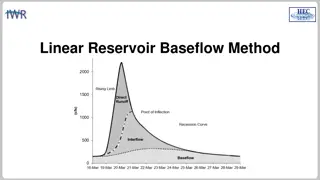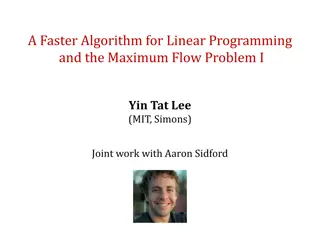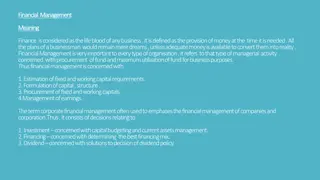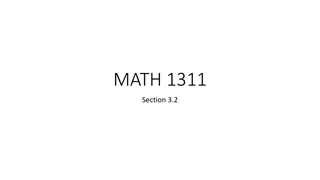Linear Programming in Profit Maximization for Boutique Chocolatier
Linear programming is utilized to maximize profits for a boutique chocolatier offering two types of chocolates. By assigning values to the production quantities of each chocolate type, and considering constraints like demand limits and production capacity, the chocolatier can determine the optimal production mix to maximize profits efficiently.
Uploaded on Sep 08, 2024 | 1 Views
Download Presentation

Please find below an Image/Link to download the presentation.
The content on the website is provided AS IS for your information and personal use only. It may not be sold, licensed, or shared on other websites without obtaining consent from the author.If you encounter any issues during the download, it is possible that the publisher has removed the file from their server.
You are allowed to download the files provided on this website for personal or commercial use, subject to the condition that they are used lawfully. All files are the property of their respective owners.
The content on the website is provided AS IS for your information and personal use only. It may not be sold, licensed, or shared on other websites without obtaining consent from the author.
E N D
Presentation Transcript
Linear Programming CISC5835, Algorithms for Big Data CIS, Fordham Univ. Instructor: X. Zhang
Linear Programming In a linear programming problem, there is a set of variables, and we want to assign real values to them so as to satisfy a set of linear equations and/or linear inequalities involving these variables, and maximize or minimize a given linear objective function. 2
Example: profit maximization A boutique chocolatier has two products: its flagship assortment of triangular chocolates, called Pyramide, and the more decadent and deluxe Pyramide Nuit. How much of each should it produce to maximize profits? Every box of Pyramide has a a profit of $1. Every box of Nuit has a profit of $6. The daily demand is limited to at most 200 boxes of Pyramide and 300 boxes of Nuit. The current workforce can produce a total of at most 400 boxes of chocolate per day. Let x1 be # of boxes of Pyramide, x2 be # of boxes of Nuit 3
LP formulation A linear equation of x1 and x2 defines a line in the two-dimensional (2D) plane A linear inequality designates a half-space (the region on one side of the line) The set of all feasible solutions of this linear program, that is, the points (x1,x2) which satisfy all constraints, is the intersection of five half- spaces. It is a convex polygon. 4
Maximize Profit Find point(s) in feasible region (shaded part) at which objective function (x1+6x2) is maximized. feasible region: a polygon feasible regions decided by linear constraints Note: All points on line x1 + 6x2 = c (for some constant c) achieve same profit c e.g., points (0, 200), (200, 1000/6) lie on x1 + 6x2 = 1200, both yield profit $1200 (0,200) (200,1000/6) so are all points in the line segment 5
Maximize Profit (contd) All points that lie on line x1 + 6x2 = c (for some constant c) achieve same profit c As c increases, profit line moves parallel to itself, up and to the right. To maximize c: move line as far up as possible, while still touching feasible region. Optimum solution: very last feasible point that profit lines sees and must therefore be a vertex of polygon. 6
Maximize Profit (contd) All points that lie on line x1 + 6x2 = c (for some constant c) achieve same profit c As c increases, profit line moves parallel to itself, up and to the right. To maximize c: move line as far up as possible, while still touching feasible region. Optimum solution: very last feasible point that profit lines sees and must therefore be a vertex of polygon. 7
Simplex Method Simplex method: devised by George Dantzig in 1947. Starts at a vertex, and repeatedly looks for an adjacent vertex (connected by an edge of the feasible region) of better objective value. In this way it does hill-climbing on vertices of the polygon, walking from neighbor to neighbor so as to steadily increase profit along the way. Upon reaching a vertex that has no better neighbor, simplex declares it to be optimal and halts. Why does this local test imply global optimality? considering think of profit line passing through this vertex. Since all the vertex s neighbors lie below the line, the rest of the feasible polygon must also lie below this line. 8
A few comments Simplex Method is a kind of hill climbing technique: a mathematical optimization technique which belongs to the family of local search. It is an iterative algorithm that starts with an arbitrary solution to a problem, then attempts to find a better solution by incrementally changing a single element of the solution. If the change produces a better solution, an incremental change is made to the new solution, repeating until no further improvements can be found. 9
A few comments Linear programming: a special case of convex optimization. Convex optimization: minimizing convex functions over convex sets. Simple ex: What if objective function is: maximize x12+x22 ? What does the profit lines look like? 10
Simplex Algorithm: details Convert the problem into standard form 11
Simplex Algorithm: detail Convert standard form into slack form slack form: (N, B, A, b, c, v) N: set of non-basic variables (those on the right hand sides, and in object functions) B: the set of basic variables A: matrix (ai,j) (bi): the vector (ci): the coefficients in object function Basic solution: set all non-basic variables to 0, and calculate basic variables accordingly. 12
What if basic solution not feasible? or the problem is not feasible, or is unbounded? 15
Practice Consider the following linear program: plot the feasible region and find optimal solution What if objective is to minimize 5x+3y? 17
Higher Dimension What if there is a third and even more exclusive line of chocolates, called Pyramide Luxe. One box of these will bring in a profit of $13. Nuit and Luxe require same packaging machinery, except that Luxe uses it three times as much, which imposes another constraint x2 + 3x3 600 18
Another Problem Duckwheat is produced in Kansas and Mexico and consumed in New York and California. Kansas produces 15 shnupells of buckwheat and Mexico 8. New York consumes 10 shnupells and California 13. Transportation costs per shnupell are $4 from Mexico to New York, $1 from Mexico to California, $2 from Kansas to New York, and $3 and from Kansas to California. Write a linear program that decides the amounts of duckwheat (in shnupells and fractions of a shnupell) to be transported from each producer to each consumer, so as to minimize the overall transportation cost. 19
Transport Networks Given a directed graph G=(V,E), two nodes s, t in V (source and sink), and capacities ce on edges Model some transport system (a network of oil pipelines, computer networks, ) Question: How to transport as much as goods from s to t using the network using? A Network 20
Flow in Networks A shipping scheme/plan assign fe to each edge, and has following properties 0<=fe<=ce (capacity) for all nodes u except s and t, amount of flow entering u equals amount leave u (conserved) A flow in the network: value is 7 21 A Network
Max. Flow in Networks Input: G=(V,E), edge capacity ce Output: fe of each edge (# of var = |E|) Linear Programming problem constraints are all linear! maximize: f(d,t)+f(e,t) A flow in the network: value is 7 22 A Network
Ford-Fulkerson Alg. Input: G=(V,E), edge capacity ce Output: fe of each edge (# of var = |E|) A flow in the network: value is 7 23 A Network
Summary Linear Programming: assign values to variables subject to linear constraints, with goal of minimizing (or maximizing) a linear function Many problems can be formulated as LP if values can only be integer, then it s a harder problem e.g., Knaksack problems Ideas of Simplex alg. 24























